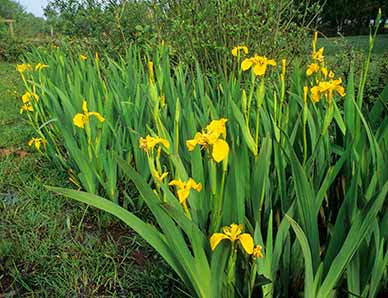Yellow iris (or yellow flag) (Iris pseudacorus)
When: May - June
How many: Fairly widespread, sometimes in dense clusters

Standing at a height of up to 150 centimetres (60 inches) and with vivid yellow, occasionally white, flowers, the yellow iris is perhaps the most striking plant to be found in the New Forest.
Yellow iris flowers in May and June, and can be found in damp ground, often at the margin of slow flowing streams and along the edge of grassland drainage channels.
Yellow iris spread is through substantially-sized seeds that float away to find new ground, and also through underground, fleshy rhizomes. These horizontal stems produce new plants at intervals along their length, and double as food storage mechanisms. They are adapted to survive in the airless, waterlogged soils in which the iris is found.
But not only is yellow iris an attractive feature of the landscape, it also provides ideal support for metamorphosising dragonflies and damselflies - look out for empty, discarded larval cases on the stems of yellow iris: they remain attached for a number of weeks before being dislodged by wind or rain.
Herbalist John Gerard, writing in the 16th century, called the yellow iris, water floure de-luce and also water flag and yellow flag - the latter name is still in current use. Gerard also described the ‘long and large flaggy leaves like the blade of a sword with two edges’, which gave rise to other country names: sword flower and sword flag.
Yellow iris seeds, roasted, were once used to make a coffee-like drink, whilst the rhizomes were used to produce black dye and black ink. The plant also had astringent qualities, and was much valued for stopping the flow of blood.
References:
The Encyclopedia of British Wild Flowers: John Akeroyd
Reader’s Digest Field Guide to the Wild Flowers of Britain
Collins New Generation Guide - Wild Flowers of Britain and Northern Europe: Alastair Fitter
The Englishman’s Flora: Geoffrey Grigson
The Herball or General Historie of Plantes: John Gerard
More links
Other related links
Search this site

Sadly, 58 animals were killed - 35 ponies, 13 cows, 8 donkeys and 2 sheep, whilst a further 32 were injured - 3 pigs, 9 donkeys, 11 cows and 9 ponies.
(Forty-three accidents occurred in daylight, 15 at twilight and 101 in the dark. Twenty-seven accidents were not reported by the driver involved).
Here's just one horrific example - Three donkeys killed in collision with van at notorious New Forest blackspot (Advertiser and Times)

